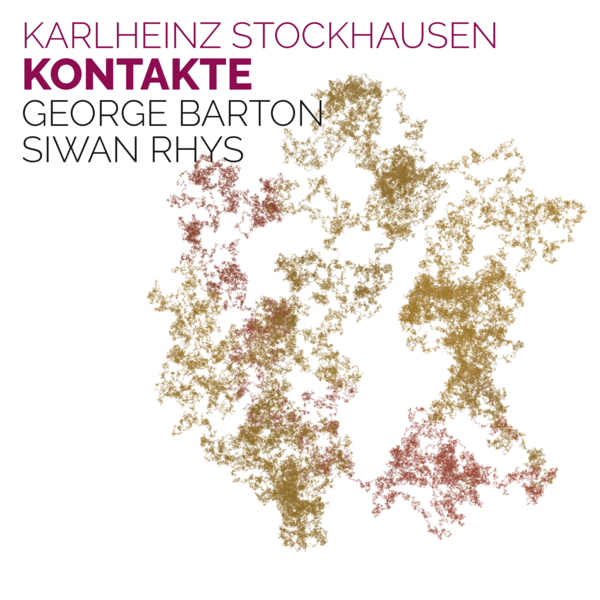
Karlheinz Stockhausen
KONTAKTE
George Barton
Siwan Rhys
atd9
binaural download only

This recording of Stockhausen’s KONTAKTE (realised 1958-60 and enticingly catalogued in this version for electronic sounds, piano and percussion as ‘Nr. 12 ½’) captures in high-definition the technicolour ‘contacts’ between instrumental and electronic sounds and the many and varied forms of spatial motion that a listener experiences in live, immersive performances of the work. Performed by GBSR duo from memory and mastered for headphone listening in surround-sound binaural format.
Critical acclaim
[Stockhausen’s] electronic music was created as a four-channel tape, and that vivid, spatial element of the work emerges with startling immediacy in this first binaural recording of the electro-acoustic version, with percussionist George Barton and pianist Siwan Rhys. Heard through headphones, their performance gives a tingling sense of the aural perspectives that played such an important role in Stockhausen’s musical thinking at that time.
Tracks
| 1 | KONTAKTE | 35:05 |
Our thanks go to the Stockhausen-Stiftung für Musik (Kürten, Germany) for granting the rights to record with the four-channel tape part of KONTAKTE. More information about the foundation and their work can be found at karlheinzstockhausen.org and stockhausen-verlag.com. The original stereo recording of KONTAKTE can be found at stockhausenCDs.com. This recording was supported by the London Contemporary School of Piano.
Liner notes
Here, time becomes space. The aura of the grail in Richard Wagner’s Parsifal leaves some residue on Stockhausen’s KONTAKTE, however distant the worlds of these two composers may seem. Indeed, the impulse to unify the arts and, it has to be said, the scale of the artists’ ambitions, arguably makes Stockhausen the real successor to Wagner, in KONTAKTE as much as the seven-opera cycle LICHT. What’s more, both composers were, in essence, theatrical beasts. Although Stockhausen’s works of the 1950s tend to be seen as earnestly technocratic, KONTAKTE, from its stage set-up and surround sound, to its titular and structural focus on moments of contact between individual agents, is inherently dramatic in conception.
KONTAKTE was first realised between 1958 and 1960, at the Westdeutscher Rundfunk electronic music-studio in Cologne with the assistance of composer Gottfried Michael Koenig. There are two versions, one designated ‘Nr. 12’ in the composer’s catalogue, which is for electronic sounds alone, and a second version, ‘Nr. 12½’, for electronic sounds, piano and percussion. In both, Stockhausen extended the serial principle beyond pitches, durations and intensities, to encompass aspects of shape (attack and decay type, the ‘swell’ of sustained electronic sounds), sound (piano, percussion, and electronics) and spatial behaviour (determining not only location but types of spatial motion, speed, apparent spatial volume of ‘fill’, envelopment, and so on). This ‘total serialism’ can be thought of as providing a foundational coherence to the piece.
However, in KONTAKTE Stockhausen adopted a new structural device that seemed intent on provoking discontinuities: moment form. Each ‘moment’ is an independent formal unit, singular or modular, static or dynamic, short or long, or some combination of types. The purpose is to avoid linear narrative. In his 1963 essay ‘Momentform’, Stockhausen explained that such pieces:
neither aim at the climax, nor at prepared (and consequently expected) multiple climaxes, and the usual introductory, rising, transitional and fading-away stages are not delineated in a development curve encompassing the entire duration of the work. On the contrary, these forms are immediately intense and seek to maintain the level of continued ‘main points’, which are constantly equally present, right up until they stop. In these forms a minimum or a maximum may be expected in every moment, and no developmental direction can be predicted with certainty from the present one; they have always already commenced, and could continue forever.
Stockhausen’s combination of total serialism and moment form might be understood as a kind of disengagement with authorial control, because many of his compositional decisions were determined by systems rather than subjective choice. The forms could continue forever because any structure is arbitrary. However, the ways in which groups of sound interact with one another, merging to form aggregates or staying in opposition to each other, suggest that more is at stake in this music than just playing with sounds in space and time. The relationships between different ideas are dynamic and push beyond any sense of being constrained. These aspects of KONTAKTE are especially apparent in the interactions between instrumentalists, physically and sonically. Much as Wagner’s Festspielhaus at Bayreuth was intended to subsume its audience, that sense of drama is enhanced by the spatialized electronics, absorbing the listener into Stockhausen’s world.
Laura Tunbridge